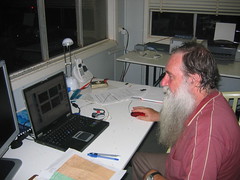The Jaisalmer train station is out of control. It is low-season and the rickshaw drivers are physically aggressive in their pursuit of business from the few visitors. Kevin resorts to clearing a path using the same method that one would use to pass through a pair of swinging double doors. One solitary and timid traveller attracts so many vigourous suitors that a policeman has to intervene.
We stay at the Paradise Hotel inside
Jaisalmer Fort and arrange our camel safari. The hotel features one exterior wall that is consistently delicious to cows.
The starting location for the safari is a thirty minute drive into the desert. There, our guide shows us how to mount our camels without bothering to discuss how a rider is to control them. My camel´s name is
Rocket. He is huge but quite gentle. He is clearly an experienced safari camel. Not only does he know the way, he also demonstrates a precise knowledge of how long he can stop and eat leaves without attracting the camel driver´s whip.
We break for lunch after walking for about ninety minutes. This walking time includes a stop in a small village where the children speak only enough English to ask for money and a water break for the camels. The lunch break lasts for five hours. Camels never seem to tire of
eating. The drivers also use this time to re-pierce one camel´s nose, something that I would have preferred not to have seen or heard.
In the afternoon, we walk further. Our destination is the dunes of the Thar Desert. The dune area is quite small, and a convoy of safari groups forms on the single track. We arrive at the dunes in the evening and, after a hearty meal, fall asleep under the stars to the sound of our guides making and recieving calls on their cell phones.
The next day we return, largely by the same track. There is more running this day. Sitting on a slow-moving camel is quite pleasant. Sitting on a running camel is quite uncomfortable. Unfortuately, after you have been sitting on a running camel, sitting on a slow-moving camel also becomes uncomfortable. In the name of better photographs, I dismount for a while. Here is a photograph of
Jen and of an unidentified
desert bandit.
Jaisalmer is a pleasant place to be and we spend a few extra days there after the safari is complete. Our top achievements in this time unquestionably include enduring a late night sandstorm that filled our room with grit, meeting jeweller who claimed his father holds the world record for writing on a single grain of rice, being informed that cows that eat plastic produce undelicious milk, and consuming countless cold coffees with ice cream.
One night in town, we also witness a wedding procession making its way through the streets. After some scholarship of the spectacle, I can report the appropriate sequence for this type of parade:
1) truck carrying an enormous generator-powered stereo playing the latest Indian pop hits
2) young men dancing or extending invitations to dance to male onlookers
3) traditional drummers
4) old men dancing
5) groom on horseback wearing a terrified expression
6) exquisitely dressed women of all ages escorting children
Note that the bride does not attend.
We make the twenty-four hour trip to Mumbai in one exhausting move. It requires twelve hours on the bus and nine hours on the train, separated by three hours of waiting in the usual train station chaos.
Mumbai is curry of black-and-yellow taxis and sidewalk vendors selling shiny things and beggar children, served on a muggy day.
As India´s final inconvenience, the departure time for my flight to Tanzania is 4:30 am.





